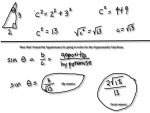silentthread
New member
- Joined
- Jan 9, 2010
- Messages
- 8
Somehow I get a different answer than the book.
Is it because radicals can NEVER be in the denominator, and I need to multiply it byitself to cancel out?
Example, if the denominator of a fraction is square root of 5, does that means I need to multiply both side by the square root of 5?
(see below)
Is it because radicals can NEVER be in the denominator, and I need to multiply it byitself to cancel out?
Example, if the denominator of a fraction is square root of 5, does that means I need to multiply both side by the square root of 5?
(see below)


